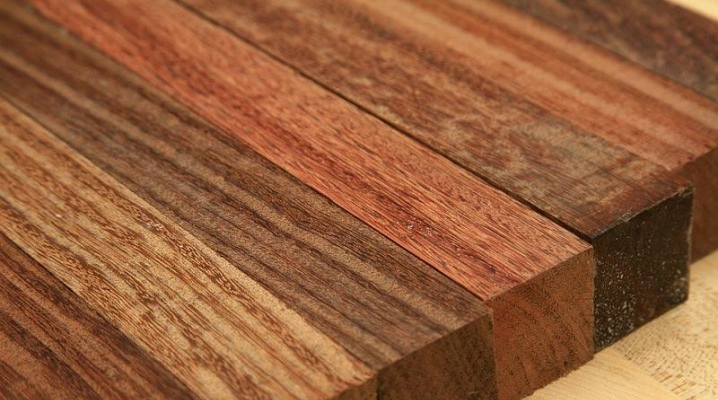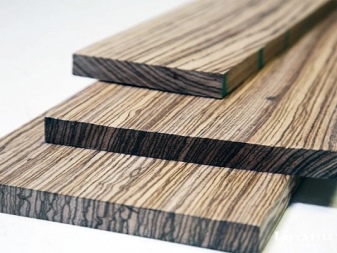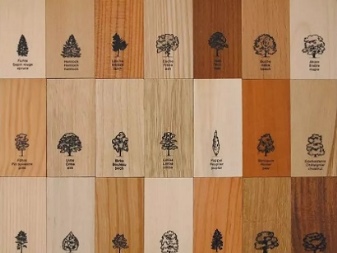All about wood species

All information about the species of wood is available only to a specialist in this industry, since the visualization and properties of the same species can be determined not only by the species, but also by the age, the place in which the tree had to grow. The growth rate naturally follows from the latter. Natural conditions determine the level of concentration of various substances contained in the cut wood. The intensity of the color of the wood, as well as its other physical properties, depend on their quantity and quality.
The demand for sawn timber can be easily explained. After all, they have a variety of valuable qualities. The purpose of their use largely depends on the type of wood. Some breeds are suitable for building houses, and some are only suitable for decoration or decoration.


What are the hardwoods?
The type of wood is called a type of lumber obtained from a specific tree with a name given by scientists when describing various types of woody plants... By their number on its territory, Russia is the undisputed leader, followed by Canada and Brazil in the top three. All this huge woodland is conventionally divided into three main broad categories - deciduous, coniferous and exotic. The classification of trees is carried out according to various criteria - they are divided into broad-leaved and coniferous, deciduous and evergreen species.
They are also differentiated according to the intended purpose of wood - valuable, shipborne, or according to the area of distribution - tropical, northern.


A separate distinction exists in deciduous and coniferous species. The former are more variable in the composition and type of the main elements.
- Hard and soft-leaved. Hardwoods are valuable oak, beech, acacia, pear and ash. Soft-leaved trees include aspen, linden and poplar.

- Linden - a representative of soil-demanding species, but birch is not. She belongs to the light-loving and growing rapidly. Linden calmly perceives shade, but grows much more slowly.

- The various characteristics of fibrous lumber imply a division into areas of application. - from anti-erosion planting, obtaining fruits and spices, to medicinal and technological raw materials. Spoons are made from birch, aspen and maple, for use in everyday life or for souvenir. Poplar and birch used to make plywood differ not only in product quality, but also in price (white-trunk trees and conifers are much more expensive and more valuable).

- For carpentry work, from deciduous trees, beech, oak and walnut are usually used, although any tree will play with a good craftsman. In the construction business, hard species of deciduous woody plants are valued, but they are chosen not for the complexity of processing, but for their resistance to decay. There is a special GOST, which divides them into resistant trees (oak and ash); medium-hard - mainly sapwood and core of wood (ash, maple, sycamore, walnut and apple); unstable (aspen, linden, birch and linden).
Starting the construction of a building made of wood, the craftsmen take into account the relative ease of its impregnation with antibacterial, fire-resistant and other ennobling compounds, the scope of application (construction, furniture, souvenir and practical products).

When finishing work, the owners, who are not constrained in funds, focus on the color, texture, pattern, which are determined by the age, species and growing conditions of the trees. Sometimes it is possible to lay out real masterpieces of art from such wood - paintings and mosaics.


What species are conifers?
In Russia, the undisputed leader in the number of trees on the planet, there are different species - conifers, deciduous and even exotic... It is difficult to determine the leader in conifers and deciduous trees, but in this case it is conifers that are most often used in construction. There are 7 families and 67 species on the planet. With a detailed study of the classification issue, you can find out that these families are divided into more than six hundred species.
They are found in Eurasia, the Americas, and (albeit in the form of endemic species) in the tropics and in Africa. Conifers are easily identified by their characteristic features: resinous, almost always evergreen (unlike deciduous trees, in which the vegetative mass falls off in the cold season). Instead of leaves, they have needles, and the fruits are always in the form of cones - dense, resembling berries or similar to fruits. A coniferous forest is a cluster of trees with needles, in which there can be different species, but certainly of the same family. In the Eurasian region, there is a large number of such trees in mountain ranges. Taiga is mainly also a coniferous forest, only located in the northern regions.


In Russia, the most common breed is spruce, but there are other varieties that are no less popular.
- Pine... This includes ophir (dwarf pine), yellow and cedar, white-haired (short tree or bushy plant with slightly different cones than coniferous). Edel is a pine tree that has blue-green needles. American pine, reaching in nature up to 35 m in height (in landscape design - no higher than 25 m, with a huge crown). Butter, known as "little curls"

- Spruce... Common spruce, which can live up to a thousand years and reach 40 meters in the wild. Siberian spruce, which retains all the properties inherent in the first variety, grows up to 30 m and has a conical crown (nature provided it so that heavy snow does not break branches). Serbian spruce is short and not very wide, it has dark needles, and the cones are light at the beginning of ripening, but copper in color when ripe. Spiny or silver spruce, can grow up to a meter in girth.
Another representative of spruce is fir, with flat, flexible and not sharp needles, with white tips and standing cones.

- Larch - endemic, the dominant breed in Russia and Canada, characteristic of boreal forests, although it is also found in the south, in the highlands. It can grow up to 45 meters. It blooms very beautifully and, unlike other conifers, sheds needle-like thin needles for the winter.

- Lesser known woody plants - hemlock, capable of reaching a height of 60 meters, with individual needles arranged in a spiral on branches. Keteleeria, (grows in the wild up to 35 m), growing in some Asian regions and on the verge of extinction.

- Cypress - known for the decorative properties of thuja, a frequent guest of urban park design. Junipers - common, Virginia, scaly, cryptometry and cypress - an invariable and beautiful decoration of the landscapes of the Black Sea coast.

- Yew - from berry yew, capable of growing up to 40 meters in height with a pyramidal irregular crown and trunk, in some cases, up to 4 meters in girth. Torea, which is a small and beautiful shrub.

- Araucariaceae - agathis, araucaria sequoia, not growing on Russian territory. Each plant is incredibly unique, interesting, with its own visual characteristics.

Despite the variety of species and forms that appeared in nature under the influence of climatic conditions and aimed at better adaptation to external conditions, the classifiers had every reason to classify them to 7 families: the presence of replaceable cones, narrow needle-like leaves, usually called needles, straightness and growing branches in the horizontal plane... Unlike larch and deciduous trees, they do not shed their needles annually and do not remain completely naked. An intensive process of photosynthesis takes place in them, which requires a lot of fluid.
In order not to lose water, the needles are covered with waxy cuticles and equipped with tightly closing stomata. It often takes more than 2 years for seeds to ripen in cones, and pollen from another tree to fertilize them. This, as well as the huge number of trees cut down and killed by forest fires every year, will eventually lead to a threatening position for the green lungs of the planet.


Douglas
A unique member of the conifer family also known as Douglas fir... Belongs to the pine family, a representative of the genus Pseudotsuga, grows on the Pacific coast, reaches a height of 100 meters, and sometimes up to 4 meters in girth. Douglas tissolistnaya is one of the Russian names, there are other options - Oregon pine, Douglas fir or Menzies' false beetle.
Under optimal conditions, it can live up to a thousand years, today the highest one does not reach 60 cm to 100 m, and the widest - 15 cm to 5 meters at the stem base. There are coastal, mountain and gray-gray (some researchers position it as a separate species).


Spruce
There are about 40 species. It is popular for its ability to survive and for the valuable properties of the timber extracted. European spruce lives in Sweden, the approximate age of which is more than 9.5 thousand years. Several species grow in Russia and, in addition to the European, there are Siberian and Finnish breeds (a hybrid species derived from the two above). You can remember:
- eastern spruce growing in the Caucasus;
- gray spruce, often found in the steppe zones;
- ayan spruce, common in the Far East;
- spruce Glen, which is only on the southern coast of Sakhalin and the Kuril Islands.
Other representatives of the large family are characteristic vegetation in Asian countries, the vast mountainous regions of the PRC, in the forests of North America.


Larch
Despite the name, instead of leaves, it has needles, which fall off annually. The Latin name for the tree was given by Linnaeus, who drew attention to the abundance of emitted resin. A Celtic or Latin (according to various scholars) root indicates a distinctive feature of a woody plant. According to experts, it is larch that is the most abundant species, occupying up to 38% of the total forest area in the Russian Federation and up to 8% of the entire world. It grows in other countries of Europe and Asia, it is found in Canada and Alaska.
Specimens up to 900 years old have been recorded, although the standard lifespan of a tree is three to four centuries. The maximum known height of larch is 80 m, but the trunk diameter rarely exceeds the 2-meter mark.

Fir
Only in cedars and firs, cones with future seeds do not grow down, but up and scatter the seeds even before they hit the ground. The name is presumably from the German word "ficht", meaning spruce, but there are versions about the etymology of borrowing from Finnish dialects or Olonets dialects. Often found in Mexico, Guatemala El Salvador and Honduras, especially in subtropical and tropical climates. The most famous types:
- Guatemalan fir, which is found in certain habitats from southern Mexico and below;
- balsamic - with a very wide distribution area;
- Himalayan or wonderful fir growing in mountainous areas;
- budscale, Siberian, Nordman, Sakhalin, whole-leaved, growing in certain regions of vast Russia.
Fir trees are not all resistant to low temperature conditions. Some of them do not tolerate frost well, but almost all known species are demanding on the composition of the soil. But they tolerate shade well and are extremely resistant to wind, unlike spruces.


Yew
It belongs to the yew family, grows slowly, reaching a maximum of one and a half meters in girth. Nothing is known about the etymology of the name. There are only assumptions. There are 9 species in the list of breeds, and the most famous are berry, Pacific, Canadian, Far Eastern and Florida. There are also Mexican yew, Sumatran yew and Wallich yew.
Frost resistance in plants is small, some species gave natural hybrids.


Pine
Refers to sound in the description of the types of wood used, although elfin trees, trees and shrubs belong to this genus. In total, there are more than 130 species in this genus. A very wide area of distribution from the equator to the North Pole, in the tropics and subtropics, in the mountains and on the plains, in the subarctic climate, where they form whole forests of great length. It is used in construction, shipbuilding, pharmaceuticals and many other industrial areas.


Exotic types
The list of tree species is extensive, compiled according to variable characteristics. Sometimes - according to the characteristic features, remote areas of growth, colors:
- Red tree (the most famous is mahogany) - in a reddish palette, decorative, may differ in a pattern on wood, but it is not used in construction, since it is not particularly durable;

- lemon - very difficult to process and expensive, rare and valuable breed, most often used in the furniture industry;

- rosewood nature has provided it with a beautiful pattern, therefore, for clients with unlimited financial capabilities, furniture, musical instruments and even parquet blocks are made from it;

- african wenge tree dark, almost black, used for small crafts, such as a knife handle or a guitar neck;

- tiger tree, used for luxury mansions (parquet) furniture or interior decoration of rooms, luxury yachts.
There are other exotic species - they include sequoia, hornbeam, sucupira (originally from Brazil), Iroko, Lapacho (iron tree), bubingo (beautiful color with a natural pattern).

Can you define?
Boards obtained from different types of wood, differ in various parameters. And the specialist does not need anything to distinguish them from each other. This process is somewhat hampered by natural defects and the lack of complete identity of characters, even within the same species. Even the most experienced specialist can find it difficult to distinguish the breeds of conifers on the board, you have to carry out an examination - the definition by macroscopic features of a cedar or pine is not immediately understood (they have homogeneous cells and material structure).
The quality of deliveries is indicated not by wide rings, but by their number and the presence of cracks, knots, resin passages. Conifers have an incomparable aroma. When sawn, both fruit and exotic trees have their own specific smell.
But definition by eye often fails even the most skilled carpenters. Therefore, without proper experience, you should be very wary of your guesses.















The comment was sent successfully.